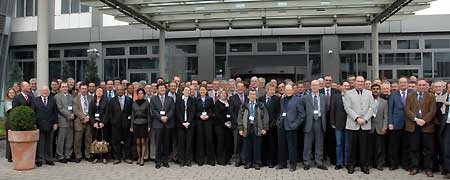
Word from the President

The High Scientific Council (HSC) plays an important role within
ENS. Its remit is to bring to the attention of the scientific
community, as well as the wider public, information on the very
latest developments in cutting edge scientific research and development.
As an expert body of senior and highly-qualified scientists it
provides a very authoritative and informed view of the latest
scientific developments taking place in the nuclear science community.
I have had the pleasure of knowing and working with a number
of HSC members for some time and always attached a great deal
of importance to what they have to say about the major issues
that are driving the international nuclear research agenda.
Part of the High Scientific Council’s mission is to report
on what was discussed and presented at each of ENS’ major
conferences. RRFM is a well-established and much-respected flagship
ENS conference. With the nuclear revival gathering momentum across
the world the work that is being carried out into research reactor
design and constantly improving fuel management is all the more
relevant and significant. The following HSC position paper was
written by Bernard Bonin of the CEA, in France, following RRFM
2008 (in Hamburg).
Before you read this interesting position paper I would like
to take this opportunity to wish you and yours a restful and – hopefully
- sunny summer break.
David Bonser
ENS President
RRFM 2008 Hamburg: An ENS High Scientific Council
position paper on research reactors. RRFM is the occasion, once a year, to review the status, operation
and evolution of research reactors around the world, including
material testing reactors (MTRs) and irradiation facilities,
neutron sources for condensed matter studies, reactors for radioisotope
production, reactors for education and training, and critical
mock-ups for reactor physics. The total number of research reactors
in the world is decreasing, as many reactors are ageing and are
not being replaced. It is hoped that this situation will stabilise
soon: a further decrease of the fleet could be detrimental to
the community. With regards to the reduction of research reactors,
the principle of “coalitions” is proposed and promoted
by IAEA, to give access to reactor to several neighbouring countries.
Such coalitions could be most effective in Latin America and
in Africa.
In Europe, there are basically three major research reactors
projects: the Jules Horowitz reactor in Cadarache (France), which
is intended to replace the ageing Materials Testing Reactor “OSIRIS” in
2014; the PALLAS facility, which will replace the High Flux reactor
in Petten (the Netherlands) and the MYRRHA project, which is
dedicated to the study of accelerator-driven sub-critical cores.
Good news from the Jules Horowitz Reactor (JHR) project has been
reported, as the financial aspects of the project have been settled
with participation confirmed from many countries, including India.
Whereas the construction of the JHR has already begun, the status
of the PALLAS and MYRRHA projects is more uncertain.

The biggest issue at the conference was the progress made in
the conversion of the cores of research reactors from highly-enriched
uranium (HEU) to low-enriched uranium (LEU). The programme of
core conversion was initiated back in 1978 under the auspices
of the US Department of Energy. It supports the minimization
and, to a certain extent, the elimination of the use of HEU in
civilian nuclear applications.
As of 2008, a total of 207 research reactors were involved in
the project worldwide. 56 have already been converted, 78 are
beyond scope, and 46 are planned for conversion with existing
LEU fuel. The remaining 28 are high performance reactors, also
planned for conversion but these will need fuel of a new type
to comply with core conversion without losing too much in performance.
The challenge for this new fuel development was extensively analysed
during the conference.
The permanent challenge of research
reactors devoted to testing or irradiation is to produce high
neutron fluxes with limited
amounts of fissile material. This in itself is a constraint as
it already points to the need for fuels with a high density of
fissile matter. Conversion of research reactor cores to LEU has
made the need for dense fuel all the more urgent. The intermetallic
compound U3Si2 is presently the reference
fuel, with a well mastered production process on the industrial
scale and
a good behaviour
profile under irradiation. But its density is only 4.8 gU.cm-3,
and this is clearly not sufficient for the conversion of some
of the more demanding research reactors. Higher densities can
be reached by switching to UMo alloy, where the 7-10% Mo additive
has been chosen for its capacity to stabilize the gamma phase
of uranium. Monolithic UMo alloy has a density as high as 16
gU.cm-3;
UMo can also be made of powder, sandwiched between two co-laminated
plates of Al. The density of the powder (called “meat” in
the specialist’s jargon) at the centre of the sandwich
is then limited to about 8 gU.cm-3. The behaviour
of this type of fuel plates has been tested under irradiation
in various laboratories,
with as yet not entirely satisfactory results. The general finding
is that the Al matrix interacts with the UMo alloy to form an
interaction layer where the gamma phase of the uranium crystal
lattice is locally destroyed, with negative consequences on the
behaviour of the fuel under irradiation (the swelling and pillowing
of the fuel plate can modify the cooling of the fuel and cause
its buckling; the fission gas release can cause blistering of
the plate and cause its ultimate rupture). The addition of 2-5%
of Si either in the Al matrix or in the UMo itself seems to limit
both the development of this indesirable, mainly amorphous interaction
region, and the resulting swelling. Reports from all laboratories
confirm the positive role of Si on the fuel behaviour under irradiation.
The phenomenology of the role of silicon is being better mastered,
as silicated phases located at the interface between UMo and
Al play the role of a diffusion barrier, which limits the development
of the amorphous interaction layer. Cumulated fission rates as
high as 5.1021 fissions.cm-3 in the fuel
grains, corresponding to burn-ups of 10 %, have been achieved
with UMo
fuels in powder
form. Alternatives to the aluminium cladding have been researched
(stainless steel, zirconium alloy), with promising results so
far. Altogether, the UMo fuel is by no means produced, even less
qualified on the industrial scale. It is hoped that the promising
additon of Si will ultimately result in a well-mastered fabrication
process, with satisfactory fuel performance under irradiation.
But progress is slow. Some of the more advanced research reactors
will have to wait for this new type of fuel to achieve core conversion.
The US National Nuclear Security Administration recently issued
a request for information, or RFI, on the nuclear industry's
capability to fabricate very-high-density low-enriched UMo fuel
for research and test reactors. According to RFI’s very
ambitious schedule, the qualification of monolithic fuel for
use in US reactors by the US Nuclear Regulatory Commission is
anticipated for 2011.
The RRFM conference was not entirely devoted
to core conversion. A significant part of what was communicated
concerned core calculation. The 2008 edition of the conference
has confirmed the generalisation of the use of Monte Carlo codes
for the neutronic calculations. Coupled neutronic-thermal hydraulic
(NTH) calculations are more and more frequently undertaken. The
IAEA has proposed to launch a Coordinated Research Project (CRP)
devoted to the benchmarking of these NTH calculations. The European
Nuclear Society welcomes this initiative and will follow its
developments.
The High Scientific Council of the European Nuclear Society
|

